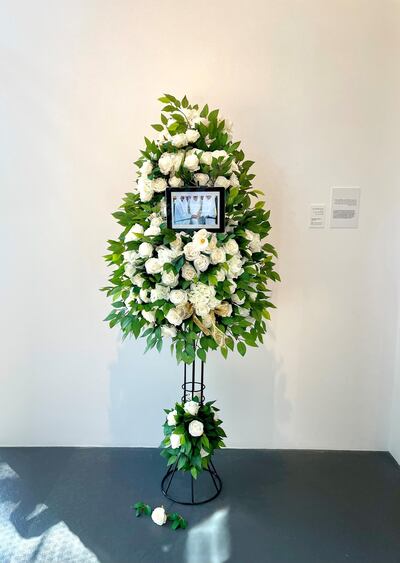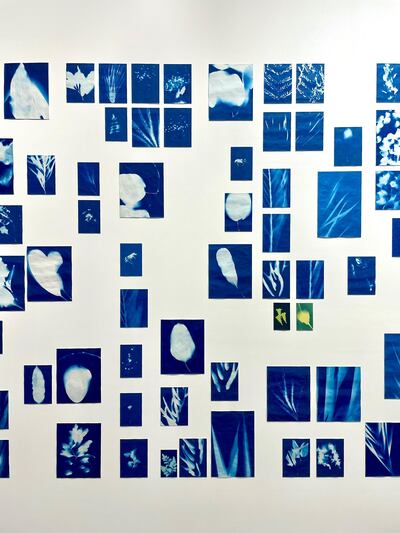The high heat of the summer serves as a reminder that the UAE spawned from desert. The country's urban structures – its skyscrapers and multi-lane highways – mask the native landscape that came before them. Many commercial and residential areas in emirates such as Dubai also boast manicured lawns, mini-parks, gardens and tree-lined streets.
Many of Dubai's property development projects and suburbs have been named to conjure up images of verdancy – The Greens, The Springs, The Meadows, The Lakes and others have ranches and hills and oases. On hoardings and architectural renderings of new developments, the presence of flora is almost certainly guaranteed. The longing for greenery in the desert is ever-present.
Total Landscaping at Warehouse421
This desire is clear in Layan Attari's Mild Life (2016) series, for which the artist captures artificial representations of nature in the UAE through photographs. The illusion of greenery is interrupted by small details – an ivy-covered wall, for example, is revealed to be nothing more than printed tarpaulin by the ripples in the material; a cluster of palm trees is merely a sticker, betrayed by a tear. Attari's works are part of the Warehouse421 group show Total Landscaping, which looks at the relationship between urbanisation and plant life, particularly in the Gulf and the global south.
Curated by Murtaza Vali, the exhibition is the third in a four-part series about Gulf urbanism titled Substructures: Excavating the Everyday. "Total Landscaping examines the ways in which nature is experienced within Gulf cities, as a scene, as a prop, as a screen, rather than as a form of life," he explains in a video tour of the show.
Many of the works in Total Landscaping operate like Attari's, where a second look opens up different meanings behind the image. In Yee I-Lann's The Orang Besar Series YB 1-10 (2010), a series of photographic vanitas, boutonnieres of tropical flowers worn by various dignitaries in the artist's native Malaysia appear bright and vibrant, but are actually wilting.
Filipino-American artist Stephanie Syjuco, on the other hand, strips flowers of their colour in Neutral Orchids, a work from 2016. Covered in grey spray paint, the plants are turned into sculptural 3D digital models – a critique on how the species, which thrive in tropical climes, have been labelled "exotic" and used as a symbol of affluence.
The treatment of plant life as mere ornaments is also in collective GCC's Ceremonial Achievements in Flowers, a 2013 installation comprising a floral arrangement and an iPad playing a slideshow of ribbon-cutting ceremonies. Much like the wreath, which turns out to be plastic, the ceremonies are mere display.
One of the exhibition's most important works is Ho Rui An's lecture performance Screen Green from 2015, a recording that plays on a loop. Inspired by Singapore Prime Minister Lee Hsien Loong's use of green-screen technology during a national day rally speech in 2014, Ho considers how urban greening projects also act as a projection for political aspirations and the state's ambitions to become a "garden city", and more recently, "a city in a garden".
“Ho discusses the ways in which these two types of screens, the digital green screen and the use of nature as backdrop, are intertwined within the narrative of Singapore and that they are used as a way to market the city as a tropical landscape, but not one that is wild, one that is tamed and controlled,” Vali explains.
In the Gulf, urban greening and projects by private entities take on a similar form. Here, green spaces communicate more than beauty. They signify a kind of victory, a point of pride, to be able to turn the barren into something bountiful. In Vali's curatorial text he references landscape architect Gareth Doherty's book Paradoxes of Green, in which green, in the context of Gulf urbanism "has come to signify wealth and progress, privilege and power".
Many regional projects have centred on subverting the climate – the buzz of "skiing in the desert", the capacity to build an indoor rainforest or grow a "miracle" garden.
Such undertakings extend back to the UAE's beginnings, as described in architect and author Todd Reisz's texts, which accompany Hind Mezaina's captivating Dubai Gardens (2017), cyanotype prints of leaves and flowers collected from the emirate's green spaces. Reisz shares vignettes of various attempts to create green spaces in the UAE, from the arrival of British agriculturists to the appointment of a Pakistani gardener, Saari, by Sheikh Rashid bin Saeed, former Vice President and Ruler of Dubai, to greenscape Port Rashid.
The texts bookend Mezaina's "botanical portrait" of Dubai, inspired by the work of photographer and botanist Anna Atkins. The exhibition text states that Mezaina's samples come from green spaces that are "both natural and man-made, public and private, ornamental and functional". In these ghostly white outlines against dark-blue prints, the species are left unrecognisable, able to shed attachments of politics and power, and instead bring focus to nature's forms.
Total Landscaping is on view at Warehouse421, Abu Dhabi, until Sunday, July 4.More information is at warehouse421.ae











